I'm Gabbie and all photos used are my own, unless otherwise stated.
Don't wanna be here? Send us removal request.
Text
I can tell you’re a very dedicated person, and I’m glad to know that so many people in our generation are just like you and I; valuing integrity just as much as inclusion and hard-work. There’s an incredible dynamic in this course between science, or the accuracy and level of information, and art, where we use emotionally knowledgeable ways to reach out to the people around us and be able to touch their hearts as well as their minds. Especially when it comes to nature, since in many generations development and industrialization was associated with good, after all it’ll make things cheaper (and therefore easier for poorer families to live) so how could it not be good? But now people are realizing the consequences of decades of exploiting nature, the source of all of our needs, as well as desires; food, clothing, cleaning products, paper, pencils, pens, stickers, ink, electronics, none of what we have today would be possible without the earth.
My personal code of ethics and developing as an interpreter
When I think of ethics, I think about the various business courses I have taken and how a business will have a code of ethics. However, I have never really thought about what my own personal code of ethics would look like. My understanding of ethics from business class would involve parameters for appropriate behaviour based on morals. My personal code of ethics would then act as guidelines for my actions based on the morals I hold. There are many moments in life where I have to choose between two alternative and my own code of ethics plays an important role in the decision I make. Especially as I develop as a nature interpreter my personal code of ethics will impact the groups that I am guiding on interpretive walks or programs. This makes developing my personal ethic very important.

Photo from colourbox (2019).
I think that my personal ethics have developed since I was a child from learning and discovering the world. These are also constantly evolving as I continue to learn about the world and become an adult. There are four ethics I would like to talk about in this blog post: honest and integrity, hardworking and sincere, respect and be prepared.
Honesty and Integrity The truth matters to me. I think it is important to stand up for what is right and just. As a child my parents taught me important values such as honesty and compassion. I quickly learnt the importance of these values because my actions had consequences as a child such as getting a time out. Today as an adult this is still true only the consequences are different. As I develop myself as a nature interpreter, I think that honesty and integrity becomes even more important because the actions I make set an example for others. For example, as a nature interpreter it is important to me that natural landscapes be protected for future generations. To encourage others to be mindful of their own impact on the environment I need to show this to lead as an example for others. It is my responsibility as a nature interpreter to not only provide accurate information on the subject of climate change but also to stand up for the protection of the environment as various issues threaten the conservation of species and landscapes.
Hard work and Sincerity I am hardworking and sincere. It is important to me that I am dedicated to the activities and tasks that I am doing to fulfill my ambitions. I am developing this with each challenge I am met with in my life. Especially since attending university I have been able to over come many challenges and work hard to achieve success. This has made me not afraid to take on difficult tasks. I think this becomes more important as I develop as a nature interpreter because it can be challenging to relate the subject of nature to the variety of peoples live in an audience to offer a “spark” (Beck & Cable, 2011). I have received this “spark” from other nature interpreters that has made a lasting impression on my life. Now as a nature interpreter myself I need to develop this skill of offering the “spark” to others. This will take hard work to develop and practice as I improve in nature interpretation. It is my responsibility as a nature interpreter to understand my audience and what they are interested in to relate my message to the knowledge and experience of the audience and provide an engaging and meaningful experience. This includes catering to different types of learners in the audience such as active and reflective, sensing and intuitive, visual and verbal, sequential and global learners.
Respect I think it is important to be respectful. This ethic has been with me since elementary school and into high school. I developed this because my elementary school motto was: “treat others the way you want to be treated” and in high school the motto was: “respect: give it, get it”. This has stuck with me ever since, highlighting the importance of respect and treating others fairly. As I develop myself as a nature interpreter and communicating to a wide variety of audiences it is important to be respectful to everyone. Especially as everyone carries their own invisible backpack. Being aware of this as a nature interpreter means respecting everyone regardless of what someone might have or not have in their invisible backpack (McIntosh, 1989). It is my responsibility as a nature interpreter to be aware of the privileges I have in my life and not assume things about other peoples lives. This way I can be inclusive to everyone as a nature interpreter.
Be prepared Another important motto I carry with me is from girl guides and that is “be prepared”. In girl guides this meant that guides are ready to cope with anything. I think that as I develop myself as a nature interpreter being prepared means planning for interpretive activities and programs. I also realize as a nature interpreter there are risks in any activity or program. Despite every effort to be prepared incidents can still happen. I carry with me as a nature interpreter the lemon theory to avoid accidents when be prepared isn’t enough. I am still developing my skills as a nature interpreter to manage risks in outdoor activities. It is my responsibility as a nature interpreter that my priority is everyone’s safety when engaging in various outdoor activities (Hahn, 1960). There is an element of being prepared with planning to avoid risks however as a nature interpreter I need to develop my ability to risk manage because accidents are not planned and can be out of my control
My approach to nature interpretation is rooted in my love for beauty in the environment and being able to help people see this for themselves. Because beauty is subjective, and nature is dynamic there is always some aspect of nature that everyone can view as beautiful it just might not be obvious at first. I express the beauty I see in nature with my creativity in photography, so my approach to nature interpretation would involve photography to help others see the beauty in nature for themselves. By helping people who might not see the beauty in nature be able too perceive this beauty can help others understand the intrinsic value of nature to encourage the protection of landscapes and species. I am passionate about protecting the environment and as a nature interpreter my approach is not only to get people engaged with nature but also call people to action to protect nature and be mindful of everyday actions that impact the environment.

Photo of me taken by my sister, to remind myself that my personal code of ethics will help me inform my decisions and help me develop as a nature interpreter (2018).
My personal code of ethics will always influence my decisions and actions when I am faced with a dilemma. Some aspects of my personal ethics are influenced by how my parents raised me and values that have been instilled in me through experiences I had as a child. Other aspects of my personal ethics I am still developing as a nature interpreter and as adult. Because of this my ethics will adapt with my personal growth as a nature interpreter. I value the many lessons and experiences this course has offered me to developing myself as an adult and a nature interpreter.
References
McIntosh, P. (1989, July/August). White privilege: Unpacking the invisible knapsack. Peace and Freedom, 10-12.
Beck, L., & Cable, T. T. (2011). The Gifts of Interpretation: Fifteen Guiding Principles for Interpreting Nature and Culture. Urbana, IL: Sagamore Publishing.
Hahn, K. (1960).Six social declines of modern youth. Retrieved from: http://www.kurthahn.org/wp-content/uploads/2017/02/2017-obt1960.pdf
8 notes
·
View notes
Text
It’s fascinating how your two photos you took while hunting can look so similar at two opposite times of the day! I don’t know much of what to say, your response to the final prompt was clearly really well thought through, and I agree with a lot of what you said. Especially about nature being more than a physical necessity; there *is* tons of evidence that nature improves mental health and well-being and hopefully as we all move into the future, we’ll be able to help spread that knowledge with everyone that we encounter.
The End of the Beginning
Throughout the semester, I have had the chance to sit down and truly dive into my own development as a nature interpreter. It has made me question what I know and forced me to look at what I believe in. After all, is that not the point of interpretation? Taking what you know and believe and sharing it with others.
Beck and Cable (2011) insist that “Visitors are more likely to listen to someone who brims with enthusiasm, who is passionate about the place, and who is fired up about his or her work.” I agree whole-heartedly with this assertion. Who wants to sit and listen to someone talk about something they don’t really care about? On the other hand, an interpreter who can actually convey the true passion they have for a topic through their programs makes you wonder what makes it so special. It engages an audience to learn more and, in the end, it may be contagious. My ultimate goal as an interpreter would be for people to leave just a little more passionate about a topic. If everyone was at least a little bit passionate, then it would contribute to a grander appreciation and respect for Nature as a whole.
The passion I hold for the environment stems heavily from my own beliefs. As I’ve mentioned in previous posts, my upbringing has had a heavy influence on my love for nature. I had the privilege of growing up in a household that highly values nature and the services it provides for us. We derive food directly from the forest and rely on the products of these ecosystems to heat our homes. This lifeline between my family and the environment instilled in me heavy respect for nature at a very young age. Natural ecosystems provide so many indirect and direct services that benefit the well-being of humans. I witness this first hand due to my upbringing, but I feel that a disconnect has developed between people and the environment in modern times, especially in increasingly developed areas. Some of our backyards may no longer be lush forests or sparkling rivers, but it’s essential we remember the benefits a FULLY functioning natural environment provides. I believe that no matter where you grew up and how much exposure you had to the environment it’s never too late to learn about the environment and be an advocate for its conservation.
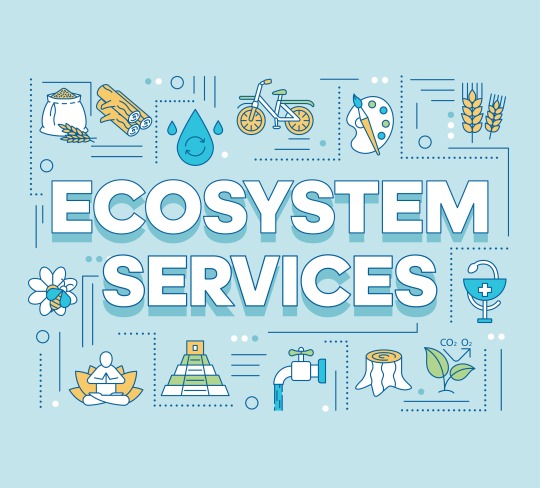
“Ecosystem services word concepts banner“ - Retrieved from Colourbox
To me, nature is also something much more than a physical necessity for survival. Countless studies have found that nature has a positive impact on our mental health and helps to uplift our spirits. Within minutes of exposure to nature, we can have a significant reduction in stress hormones (Huynh et al., 2013). I got to experience this just last weekend. Despite a busy workload, I had a chance to travel home to Kawartha Lakes to go hunting with my Dad. On Saturday I spend over 5 hours sitting in a tree stand in -17°C weather. In spite of the cold, I came out of the day refreshed, less anxious and overall less stressed. Sitting immersed in the forest, simply watching the world exist around me was like a reset button. I felt one with nature and I wish everyone could experience being able to simply enjoy the beauties of nature and the benefits it brings.
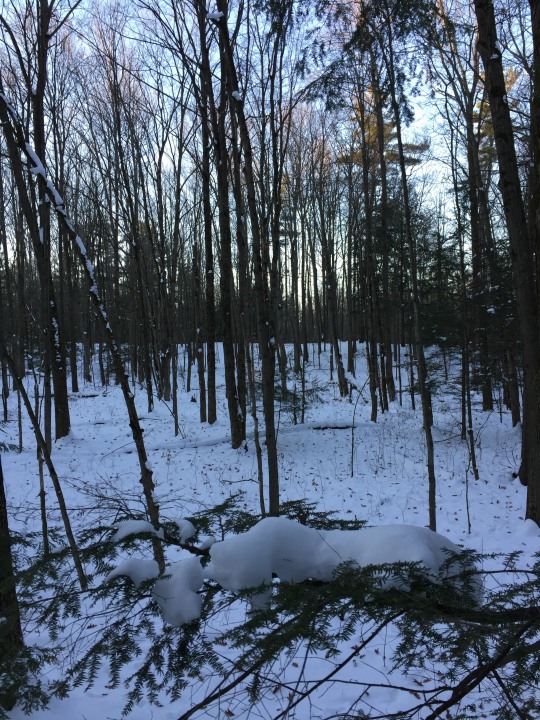
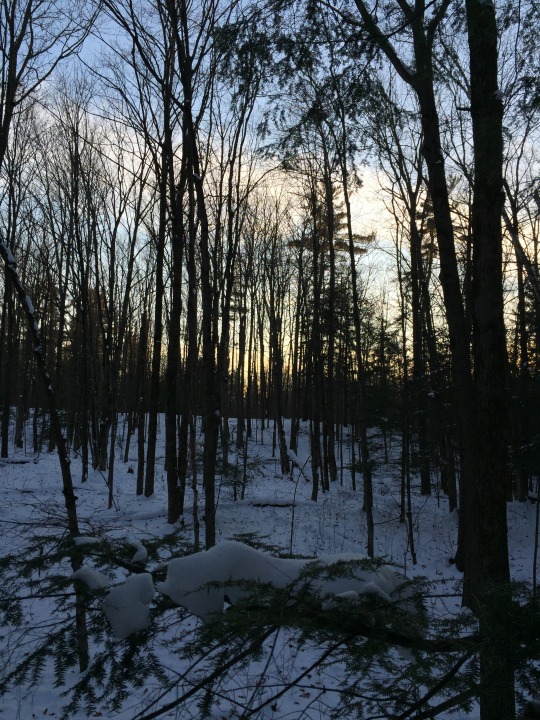
These two photos were taken exactly 8 hours apart from the same tree stand on Nov 17. There is something special about watching the sun first peak over the tree tips AND watch as it makes its final flash before disappearing beneath the horizon - Photos taken by me
As time has gone by, I find my own personal ethics and beliefs have bled into how I conduct myself as a nature interpreter. I feel I have a responsibility to share my knowledge and passion with others. Interpretation is much more than just laying out the facts for people. The National Association for Interpretation defines interpretation as “a mission-based communication process that forges emotional and intellectual connections between the interests of the audience and the inherent meanings in the resource” (Beck and Cable, 2011). What better way to cultivate these connections than weaving together a story?
“Stories entertain us. They create community. They help us to see through the eyes of other people. They show us the consequences of our actions.
They educate our desires […] And stories acknowledge the wonder and mystery of Creation.”
Scott R. Sanders’ summary of the power of stories (Beck and Cable, 2011)
Creating a story that not only shows the beauty of nature but informs people of the risks and issues can create an entertaining environment to enhance learning. I found that enjoying an experience and positive association with a program helps to increase the retention of information. I found this especially true in our labs. I enjoyed the improv lab, and I can look back on it and remember the games we played. Therefore, I am able to look back on the hidden lessons that were embedded in the material, such as the importance of focusing on prominent features that define a landscape in our ecosystem guessing game.

“Share your story It is written wooden letters“ - Retrieved from Colourbox
The question to consider now is how do I approach my self-identified responsibilities? How do I share my passion as an interpreter? As I look back on this semester, I feel I have been able to cultivate skills that will bridge the gap between an audience and myself. The most valuable approach I have taken away from this course is the ability to adapt interpretation to suit a message and/or target audience. Not every audience and topic should be dealt with the same way. Being able to think on my feet and come up with solutions and new approaches to interpretation on the fly are valuable skills when working in very unpredictable conditions. And the one thing I think everyone can agree on is the fact that nature is a dynamic landscape. Every day can bring new challenges. It was great to practice these skills, such as in the improve lab or our Arboretum guided walk. It’s also important to adapt to the times and the methods to best reach an audience. In this course, I have learned first-hand how to interpret several mediums. Our blogs and podcasts have opened my mind to new ways to deliver a message to an audience, and I look forward to further developing this in how I conduct my own social media.

“ People media connections abstract scheme” - Retrieved from Colourbox
In the end, I am walking away from this course with more skills and knowledge than I entered with. Every person has their own “invisible knapsack” (McIntosh, 1989), and as I leave, I realize that I suddenly have more tools in mine. What I carry in my own knapsack will continue to help guide me in my growth as an interpreter.
References:
Beck, L., & Cable, T. T. (2011). The Gifts of Interpretation: Fifteen Guiding Principles for Interpreting Nature and Culture. Urbana, IL: Sagamore Publishing.
Huynh, Q., Craig, W., Janssen, I. and Pickett, W. (2013). Exposure to public natural space as a protective factor for emotional well-being among young people in Canada. BMC Public Health, 13(1).
McIntosh, P. (1989, July/August). White privilege: Unpacking the invisible knapsack. Peace and Freedom, 10-12.
5 notes
·
View notes
Text
The Origins of Catholic Hill - Guelph, Ontario
Last month, my nature interpretation class went on a historical tour and walk of downtown Guelph (the city that my university is located in). I’ll only be talking about the first part, because that’s honestly most of what I remember, but don’t let that discourage you!
On my way to the meeting place, all I could think was how boring it would be and I’d have to pretend to be interested and listening so that I wouldn’t be disrespecting our tour guide. By 2 minutes into the tour though, I was thoroughly interested and absorbed in the tour and the historical facts about Guelph that I hadn’t know.
Now it was a pretty dreary day, complete with the drizzle of rain and cold gusts of wind, this hardly affected the tour though as we departed from the Guelph Civic Museum, photo books in hand. We stopped at the Statue of John McCrae, a World War II surgeon who was a born and raise Guelphite and is most famously known for writing the poem “In Flanders Fields”.
Next, we walked a short distance to the grandiose Basilica of our Lady church, which stands tall and proud, keeping watch over all of downtown Guelph from the hill she sits atop. We learned of the building process of the church and how the hill had been gifted to the Catholic church after the founder of Guelph, John Galt, has purchased the land in the early 1800s on the advice of a bishop. The basilica was initially built in 1863, with the money of Emperor Maximilian of Mexico (a friend of the Father of the Church at the time), until his assassination in 1867. Emporer Maximilian had envisioned the church to be like the massive cathedrals in Europe, and so the vision of the Basilica began; unfortunately once the emperor was killed, funding stopped and the church basically had to settle for a basilica (which in my opinion means very little considering the church is spectacularly breathtaking as it is). Over the years, the basilica was renovated and reconstructed, adding the two towers eventually to become what we see today.
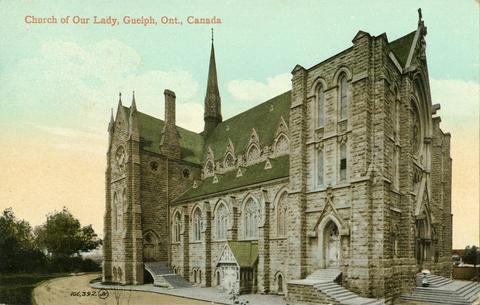
Retrieved from the Guelph Public Library photo archives. https://www.archeion.ca/church-of-our-lady-14
We continued to walk to the base of the hill where the basilica stands, our guide pointed out to the hotel across the street, called The Albion. Being university students, we thought we knew all about the Albion, many people go drink in the bar on the ground floor with friends, and they sometimes hold Throwback Thursdays on the upper floors. Boy, were we missing out, the infamous mobster Al Capone used to visit Guelph every once in a while, and would stay at the Albion hotel (presumably to see a mistress). Legend has it, when news reached Guelph of Al Capone’s death, his mistress threw herself out of a third flood window of the Albion, dying immediately.
It’s funny how you can live in a place for years and never really know anything about it. Or worse, like a child, you think you know everything there is to know, only to discover as you grow that there’s much more than meets the eye.
0 notes
Text
You wouldn’t believe the little rush of joyful adrenaline I got when I saw someone else thought of Jane Goodall the same way I do. How inspiring her passion for chimpanzees is, and dedication for a subject that wasn’t even what she had education in. I find her entire life and fieldwork completely awe-inspiring, it leaves me filled with joy and hope, especially because of her insistence of each individual person’s impact on the world and her calls to action inspiring us to be better versions of ourselves, rather than simply going on believing that what we do has no effect on everyone and everything else.
I’m not sure if your question was meant to be rhetorical, but I’m going to attempt to answer it anyways. I don’t think fame itself creates an inspiring quality to someones thoughts and actions, I think that it’s because of the inspiring quality that the person already possesses that they become well-liked, which can lead to fame if found by the right people. I think we all have some inspiring qualities in all of us, it just depends on our conviction to determine to what degree our ability to inspire is displayed. I think when someone becomes famous, nothing really changes unless they allow it to. They are still the person they were before the fame, they are just held under a microscope now where the effect of every action they take is seemingly magnified and exaggerated among their followers and the like.
What a Wild Life
I am not sure exactly when I had decided that I wanted to pursue wildlife biology (I believe it was quite young) and I’m not sure that I have a specific hero, but many have inspired me greatly and still do.
Growing up, my mum had a poster of Jane Goodall in our entrance way.

This is the image on the poster that I had growing up. What a dream! Photo by the Jane Goodall Institute Nepal.
Jane Goodall influenced me from a young age as a badass woman scientist role model. Learning about her may have been my first glance at wildlife science.
Her aspiring characteristics begin with her dedication. She did very adventurous research at a young age, going into the (now) Tanzania jungle where she discovered many things, including that chimpanzees eat meat and use tools. She talks about the immense patience needed to sit for hours and just observe.
She is also very passionate in using her fame to help the environment. She has opened institutions and programs based around conservation, education, sustainability and activism. She currently travels most of the year to share her experiences and perspectives.
“What you do makes a difference and you have to decide what kind of difference you want to make.” - Dr. Jane Goodall
These are desired traits as a scientist and educator because she demonstrates the importance of wildlife conservation through the lens of the chimp, and of moving towards sustainability through her past and what she has learned. Her characteristics ignite adventure and passion.
I am intrigued by her fame! She has made discoveries that shaped this science field but it is very impressive how large her institutions are, as very few scientists reach this fame. It gives her a very good outlet for the great education she shares.
Do you think that someone’s fame contributes to how inspirational they are?
I’ve realized in myself and many of the posts by classmates that our minds and answers are mostly famous people!
I don’t think that I will ever reach this fame, but I’ve realized that in my future, I want to emulate her passion and adventure. I feel like the present is difficult to do this as the coming years are very uncertain. I have strong interests, but not a direction to follow with wild passion, and potentially the resources to, nor the spontaneity.
I have always been very drawn to the tropics, and there are always organizations for research and travel, but I haven’t yet taken a leap and traveled anywhere. This frustrates me often, but it’s difficult to find time and money to go and explore presently. Someday!
I’ll continue to work hard in the direction of my interests and values, and maybe I can contribute to positive change.
References:
“About Jane Goodall.” The Jane Goodall Institute Nepal, The Jane Goodall Institute Nepal, 2013, https://www.jginepal.org/about/about-jgi.php.
“All About Jane.” The Jane Goodall Institute of Canada, https://janegoodall.ca/who-we-are/all-about-jane/.
6 notes
·
View notes
Text
One Last Breath, and Then Your First
I can honestly say, this has been one of the most challenging courses I’ve taken in the four years of my post-secondary degree. At times, the blog post prompts were the easiest thing I could do, and other times they were the last thing I wanted to think about because I had no idea how to approach it. Over the course of the past three months, the challenge to my creativity has skyrocketed. It’s hard on its own to push yourself to be creative when you’re busy or stressed with other classes, but at the peak of the semester when it feels like there’s so much going on and my mental health feels as fragile as tissue paper, doing something as simple as making a blog post which is supposed to be about my joy and excitement for nature and science communication seems like Mount Everest, especially since at times like this, I’m not really happy, or excited, or optimistic about anything, in fact I sometimes feel like I’m hardly hanging on by a thread and yet I have to either muster up some joy or, more often than not, completely fake it just to get a graded blog post out because neither my wallet nor my mental health can afford to fail a class.
Onto the prompt; moving forward in my endeavors to become a Nature Interpreter or something of the sort (or simply to use the quite helpful skills I’ve learned in this class) I’ll be eager to keep in mind, and question myself as to what type of backgrounds my audience may have (the experiences they’ve likely had, and what makes them tick) in order to effectively spark their interest and show them how our connections and relationships with nature are equally important as the relationships we hold with the people around us.
Of course, no matter how hard you try, you won’t be able to reach every person in the way you intended, if at all, and that’s part of the process. Even though your audience is there because they already have an interest in what your talk/walk will be about, the ways you decide to approach the topic (influenced by your personal beliefs and experiences) may cause some in your audience to turn off their ears and try to interpret the environment for themselves. And that’s okay too, because I’ll admit there are interpretive walks where I’ve tuned out because I couldn’t really care less about what the guide was saying anymore (because I had misinterpreted what the talk/walk would be about/the stance it would take on the topic) or simply because I could tell they had a very different opinion related to the topic than I did and it was influencing everything they chose to say about the topic. Which, no shade to them, they can do as they please, I simply didn’t show up to the right tour, and I may not be lead to the revelations and discoveries that they intended for me to be lead to; but I’ll end up guiding myself to my own revelations, if any. It’s the same for audience members that I may have one day; they may not reach the revelations that I intended, but as long as the experience that they had helped them to feel some sense of clarity and peace then my job is done.
Obviously, I’ll always hope that the intended effect is the effect experienced by all members of my audience. To give my audience an new personal understanding of their place in our world, the importance of their actions in a big world where they feel like a drop in the ocean. To illuminate to my audience the terrifying beauty of the interconnectedness of the world, and the wrongs that our world has endured at our hands, that one group of humans have experienced at the merciless hands of another group, in order to educate a new “generation” (that is becoming better educated on a topic brings them into a new realm of life and feels nearly rejuvinating; the beginning of a new life) and change the future of all of mankind. To conserve the natural beauty of the world, in order for future generations to be inspired by it, to be able to use it to understand the importance of the relationships and connections among all living organisms; sentient and not.
In every dull moment of mundane life on Earth, or every sad moment that drags on your feet like lead, we gratefully accept anything to give us that feeling of hope again. Whether through song or story, we learn new things to broaden our minds and to give us the ability to look upon this world with fresh eyes. When we were children, we’d beg our parents to tell us stories of when they were growing up, to hear that we’re not alone in the way we’re feeling and that life gets better; to learn of the bad things people have done in anger and fear, and provoke ourselves to feel inspired to never repeat those people’s mistakes; to learn of our place in the world, through the life, full of discoveries and learning, of a fellow human being; to feel connected to another living being, and feel even if for only a moment that we’re not alone and people care to feel a connection with us, because they give us their time; the most valuable thing in any living organism’s life.
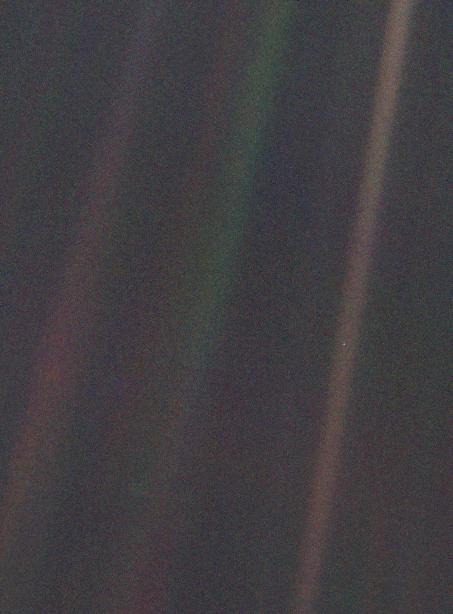
“Look again at that dot. That's here. That's home. That's us. On it everyone you love, everyone you know, everyone you ever heard of, every human being who ever was, lived out their lives. The aggregate of our joy and suffering, thousands of confident religions, ideologies, and economic doctrines, every hunter and forager, every hero and coward, every creator and destroyer of civilization, every king and peasant, every young couple in love, every mother and father, hopeful child, inventor and explorer, every teacher of morals, every corrupt politician, every "superstar," every "supreme leader," every saint and sinner in the history of our species lived there--on a mote of dust suspended in a sunbeam.
The Earth is a very small stage in a vast cosmic arena. Think of the rivers of blood spilled by all those generals and emperors so that, in glory and triumph, they could become the momentary masters of a fraction of a dot. Think of the endless cruelties visited by the inhabitants of one corner of this pixel on the scarcely distinguishable inhabitants of some other corner, how frequent their misunderstandings, how eager they are to kill one another, how fervent their hatreds.
Our posturings, our imagined self-importance, the delusion that we have some privileged position in the Universe, are challenged by this point of pale light. Our planet is a lonely speck in the great enveloping cosmic dark. In our obscurity, in all this vastness, there is no hint that help will come from elsewhere to save us from ourselves.
The Earth is the only world known so far to harbor life. There is nowhere else, at least in the near future, to which our species could migrate. Visit, yes. Settle, not yet. Like it or not, for the moment the Earth is where we make our stand.
It has been said that astronomy is a humbling and character-building experience. There is perhaps no better demonstration of the folly of human conceits than this distant image of our tiny world. To me, it underscores our responsibility to deal more kindly with one another, and to preserve and cherish the pale blue dot, the only home we've ever known.”
-- Carl Sagan, Pale Blue Dot, 1994
image credit: https://www.planetary.org/explore/space-topics/earth/pale-blue-dot.html
If I’m to become a nature interpreter, I’ll likely only work with small groups (10 or less) because I feel more disconnected with bigger groups, like no one’s really listening to what I’m saying. Whether that’s because there are too many eyes and I can’t meet all of them for a meaningful enough time to feel like I have that person’s attention, or there are too many eyes and I can’t meet all of them and so I feel that they don’t feel that they have my attention. I like a more personal connection with people even if it’s only for a short time, giving up that connection leaves me feeling adrift and purposeless; like everything I had done previously for the tour meant nothing and wasn’t heard by anyone.
I hope to feel that I have the ability to touch the spirit of all whom I come into contact with, brighten their world, and clear their eyes in order to see their world anew for the true breathtaking beauty it offers us with every passing moment.
6 notes
·
View notes
Text
My Childhood Science Heroes
They made me appreciate nature, when no one else could.

Jane Goodall. Photo retrieved from Google images.
I actually first learned of Jane Goodall 5 or 6 years ago, surprising I know, she seems so well known. The first time I learned of her, was in an introductory course in high school on Psychology, Sociology, and Anthropology, and for the longest time I mixed her up with Dian Fossey (in that I believed up until about 2 years ago that Jane Goodall was murdered by poachers - imagine my surprise).
Primarily, I thought Jane was so cool because since I was a kid I’ve loved animals and wish that I could just live some sort of Tarzan life in a jungle somewhere surrounded by them. She was living my dream life.
At the time, there was never really any media where she shared her thoughts and experiences, so unfortunately all I could get of her was 1-dimensionally what she did and where she was doing it. Sometime recently though, a documentary called “Jane” came out (I recommend everyone see it, it was quite interesting). So the most I could get from her story was knowing that that kind of life was possible.

David Attenborough. Photo retrieved from Google images.
I loved and love to listen to documentaries and clips of him talking about nature and animals. I love his voice, I’m sure everyone can agree when I say his voice is very calming. It’s fascinating to learn about all of the ecosystems around the world from him. He’s so knowledgeable, kind, and I really admire his abilities and desires to educate the world about the natural world and its importance.

Christ and Martin Kratt. Photo retrieved from Google images.
When I was a young kid, I remember watching Zoboomafoo, and while I can’t exactly remember what ever happened on the show, I was completely enthralled and I loved seeing the guest animals on the show. Chris and Martin were so silly and friendly and made things simple enough for me to understand (even as a kid), it was fun watching them getting up to their shenanigans. Plus I loved animals so any chance at watching a show that could keep my child attention span, and also had an animal theme made me super happy.
9 notes
·
View notes
Text
Ranking of Roundest Frogs
11. Australian green tree frog, Litoria caerulea
v smooth and plump. more photogenic than most people
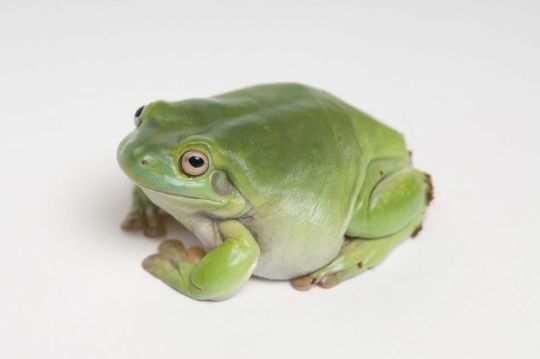
10. Tomato frog, Genus: Dyscophus
only looks like a tomato. do not eat them. beautiful smile

9. Turtle frog, Myobatrachus gouldii
great lil dude. is not a turtle, only a frog
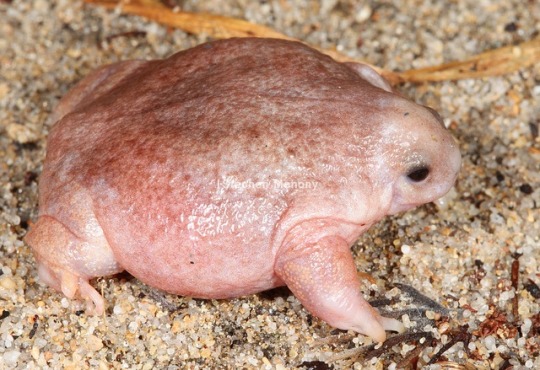
8. Budgett’s frog, Genus: Lepidobatrachus
all around great guy. was in a meme once

7. African bullfrog, Pyxicephalus adspersus
bumpy green dude
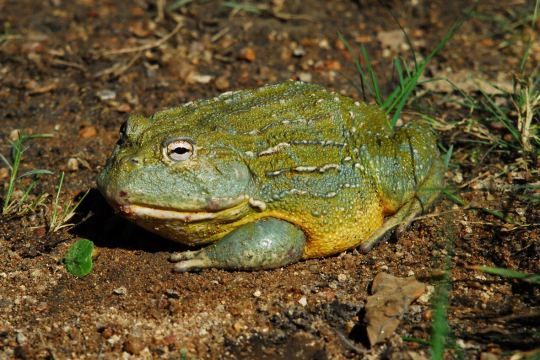
Argentine horned frog, Ceratophrys ornata
green pancake friend. nice red eyeliner
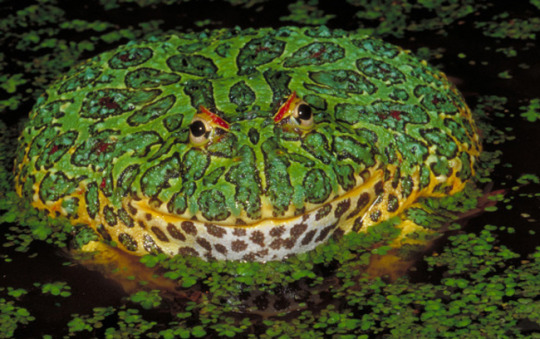
5. Banded bullfrog, Kaloula pulchra
bonus double throat pancake
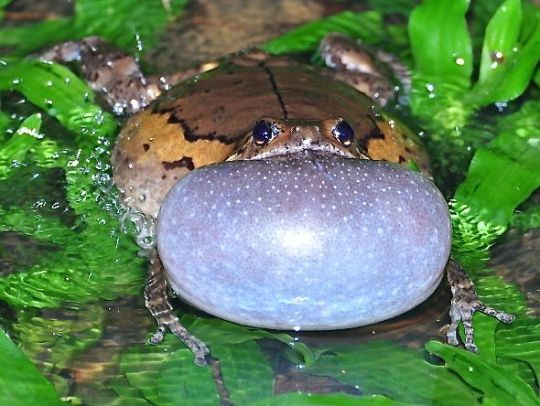
4. Purple frog, Nasikabatrachus sahyadrensis
has a weird nose and i love them

3.Black rain frog, Breviceps fuscus
angry round friend

2. Holy Cross Frog, Notaden bennettii
perfect spotty orb

1. Desert rain frog, Breviceps macrops
the roundest of all
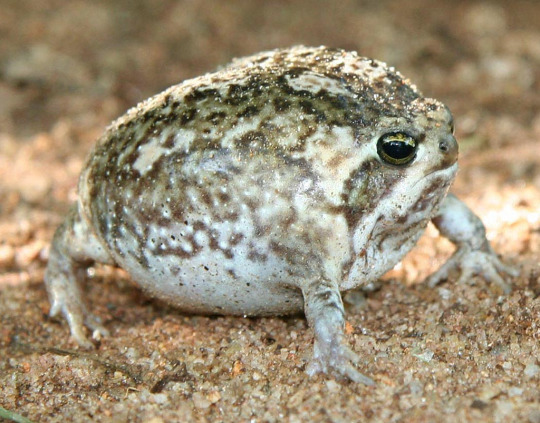
43K notes
·
View notes
Text
There are more species of ladybug than mammals. There are more species of weevil than fish. The average animal is a beetle.
Show me an “animal-lover” who hates insects and I’ll show you a hypocrite.
60K notes
·
View notes
Text
Our world is inconceivably old, many events big and small have occurred throughout its history, and many more will happen long after the human race is gone and dead. Though the world is not conscious, or at least not in a way that it can communicate to us in words, it has a mind, life, and agenda of its own. These agendas are fulfilled by thousands, if not millions, of organisms all unwittingly working toward a common goal by fulfilling their own goals. This is one of the most fascinating things about nature and our world.
If you step foot into any ecosystem, you’ll find yourself immersed in a whole new world. Once you focus on the lives of all the organisms around you, it’s easy to “zoom out” of our own lives and stresses and emotions, to focus on the many lives of the earth around us, the lives of those that don’t talk.
It only takes a few moments to feel a wave of calm as you zoom out of your life and problems, to gain a new perspective of life and the world surrounding us, of our place within this world.

A comic by false-knees. View here: https://falseknees.com/302.html
Take a few moments to go outside and just watch something, anything, from a tree branch, to a squirrel, watch how it reacts to the world, what kind of movements it makes, does it make sounds, can you identify with the things it does?
0 notes
Audio
Prompt: Where is music in nature? Where is nature in music?
Although appreciation and observation of nature usually begins and ends at sight, if we pay attention, nature engages all of our senses; sight, smell, taste, touch, and hearing. And since today’s post is about the connection between music and nature, I thought it only appropriate that I spoke to present this post (or you can read it in the transcript below).
Leo Tolstoy once said, “Music is the shorthand of emotion.”
Later, Aldous Huxley added, “After silence, that which comes nearest to expressing the inexpressible is music.”
Last week we spent the lab period creating a song with James Gordon of Guelph, Ontario. He caught my attention when he said, “Some scientists believe that song came before speech.” I didn’t deny it, I couldn’t, intuitively it would be understandable, but I decided to do some research anyways.
Here’s what I found:
- According to a 2014 Frontiers in Neuroscience paper by Schulkin and Raglan, titled ‘The evolution of music and human social capability’, “Music facilitates human [contact, meaning, and imagination]”.
- Also in 2014, an article was posted on the BBC earth website, investigating the connections between music and man. In the article they state that, “Musical instruments are just 40 000 years old” (Barras 2014).
- But music and song is much older, and many scientists believe it allowed our ancestors to communicate before language came into existence.
- Many archeological-antropology researchers believe that it wasn’t only our ancestor Homo sapiens that used music to communicate, but Neanderthals as well. Although, obviously, it’s impossible to prove the existence of music and song at any point in time, since there’s no way of preserving it physically. Meaning the earliest confirmed use of music is of a bone flute from Slovenia that is about 43 000 years old (Barras 2014).
- Biologically, it’s possible that the full vocal range of humans was reached at least 530 000 years ago (Barras 2014); a time at which both Neanderthals and Homo sapiens existed (along with many lesser known species of the Genus Homo).
I don’t know about you but when I imagine multiple Homo species using music in ways of communication, I have to wonder if maybe it was used for interspecies communication within the Genus Homo. After all, music needs no words to communicate emotion, so there would be no language barrier.
Even while simply speaking, many phrases have a natural melody, maybe it’s because of our vocal origins. Maybe at a time, sound was a lot more crucial to communication than words.
I know it seems like I’ve been avoiding answer the prompt questions, and I won’t deny that, because to be honest; it’s true. I don’t think there’s much to say about music’s place in nature and nature’s place in music. All sounds we hear in music are the descendants of the sounds we, or our ancestors, have heard in nature at some point. There’s no way to know a sound unless you’ve heard it before. And nothing is so able to stimulate our emotions as sound. And wouldn’t you agree that the goal of communication is to create a momentary emotional alignment between two individuals otherwise divided by separate physical bodies?
Listen to these Songs
youtube
youtube
youtube
youtube
youtube
References
Schulkin, J., & Raglan, G.B. 2014. The evolution of music and human social capability. Front Neurosci. 8:292.
Barras, C. 2014. Music may have originated with animals, allowing our distant ancestors to communicate and build societies. BBC earth. Available at: bbc.com/earth/story/20140907-does-music-pre-date-modern-man/
0 notes
Text
Foregoing your Right to Beauty
Two weeks ago we received a prompt, “Who are you to interpret nature through art? How do you interpret ‘the gift of beauty’?”.
Needless to say the prompt stumped me, I had many intuitive responses to the prompt but I felt as though the words I used weren’t doing my intuition justice. Even now, I hesitate to make this post because I feel like I’ll be disappointed at the outcome.
When initially reading the prompt, I felt baffled, after all who is anyone to not interpret nature through art? Observing the beauty within all the intricacies of nature is a right to any sentient organism with eyes, in my opinion. The fact that I want to be able to interpret nature effectively for people one day is less about the skill I’ll gain but the lives of the audience that I’ll be given an opportunity to influence; to brighten their every day by bringing their attention to the parts of nature around them and how connected we are to it, even if we don’t feel it at times.
David Attenborough understands that the less nature we’re exposed to the less we’ll care for it (in other words; feel a connection to) when he says; “One of the consequences of living in great cities in great masses is that we are cut off from that natural world. If we lose that sense of wonder, you’ve lost one of the most important things in your life.”
youtube
A Voice for the Planet video posted by the World Economic Forum on September 19th of this year.
I, personally, interpret the gift of beauty as the olive branch extended by all things in this world, living or dead. This olive branch is the offer to reveal their modest and unique beauty in exchange for your effort and attention, in order to make you better understand your place in the world around you; the connection and dependency between all things, mentally, physically, and spiritually.
To refuse this olive branch is to deny one’s interconnectedness with the rest of the world that they live in, and this will only ever lead to failure and death; whether of the world around them until they realize their reliance on the world when it’s too late, or of themselves in the form of a naive self-centeredness blinded by the hubris of man to dominate all things.
“Art is the only substitute for an experience we ourselves have never lived through.” - Aleksandr Solzhenitsyn
In another video, the connection between the Fyodor Dostoyevski quote, “Beauty will save the world.” and the 2012 film of Cloud Atlas is explored, detailing the concepts of interconnectedness, art, predacity, and morality. This video impresses upon the viewer the importance of individual action, even though a single individual may be the only one to do that action, because “One drop of truth can outweigh an ocean of lies” (Aleksandr Solzhenitsyn), and interestingly, David Mitchell (author of the book ‘Cloud Atlas’) adds to this quote, “What is an ocean but a multitude of drops?”. Illustrating that each individual makes their choice and it is logged with the masses, and I would like to add additionally that, like an ocean, this drop of choice can be evaporated to the sky to be remade into a new drop (perhaps even a different drop), giving us the opportunity to update our action with every moment we live.
youtube
1 note
·
View note
Photo


Mutualistic pairs for an “Odd Couples” Valentine’s program at my work. (Why do so many of my big work projects revolve around Valentine’s programs?)
Also, by “sea bugs,” I obviously meant “gnathiid isopod larvae.”
140K notes
·
View notes
Text
Restoring Balance
Do you ever get that feeling that the universe has been pointing you toward certain discoveries and experiences so that it may culminate in personal growth and understanding?
For me, it started with our class visit to the art gallery, where among the many exhibits on display one in particular stuck out to me, and I still quite vividly remember (even 2 weeks later); it was called ‘Deer Road’ by Tina Guyani.
It was a room that could fit maybe 60 people standing, bare hardwood flooring, 3 walls painted white and the fourth (on the right-hand side) painted a bright orange. The orange of the wall catches the light in a way that makes it glow, bringing warmth to the rest of the room. On the floor, on opposite sides of the room, are the heads of two bucks (male deer), both with uniquely decorated antlers and blankets, with traditional indigenous patterns, draped over their necks. Each is wearing identical masks, as they look at one another. By the orange wall hangs traditional-style buffalo hide artwork depicting man, construction equipment and clear-cut forests spread around the edges, while in the center is the figure of a buck. Underneath this hide is an old printed photo of an indigenous woman.
On the other side of the room, there is a video projected onto the wall; a walk through a wooded area, where we come across environmental tape as well as ribbons tied to many trees. The tape and ribbons are promptly and purposefully removed as we encounter each of the marked trees. All the while the audio is that of nearby construction work.
Toward the back of the room, beyond the projection is another old printed photo of another indigenous woman, with strips of the patterned cloth laid out in front of her, and to each strip of fabric there is a lline of pennies stitched.
In the center of the room there is another patterned blanket that seems to tell a story, but there is a large hole cut out of it, and place inside of the bare circle is a pile of pennies.
What do you make of this? If you’re like me, you probably felt some sort of hint of intuitive understanding of the meaning behind the exhibit... and yet it’s mildly overwhelming and difficult to put into words.
I’ll be honest, I can’t remember where or when the background story took place, but it affects me profoundly nonetheless. A group of indigenous people were deceived into giving up their land to the government, for what some of their people thought would benefit them, so that a highway construction project could be completed. In the end, it did not benefit anyone except for the government and those who used the highway. The native people who had given up their rights to their land would be given some money each year for the sacrifice they made, but what they didn’t tell them is that it would only be available to those who were determined to be properly of that group, whether they had lived on that land their entire lives or not. This left many of them who had been decidedly categorized as not true members of that indigenous group, and consequently out of their homeland as well as out of the agreed compensation for the eviction.
The ribbons seen in the projected video were actually a tradition of the native group, where they would make a wish or prayer on the night of a full moon, then venture into the woods and tie their wish to a tree branch. Also in the video, many of the trees tied with ribbons were also tied with the environmental tape, and those trees tied with the environmental tape had been deliberately targeted for removal.
When driving through the area again many years later, someone recognized the area that they had grown up in all their life (until they had been forced to leave), and yet the land would be a stranger to them. The trees cut and cleared, a five-lane highway running over what used to be their home. They felt a wave of intense emotion; grief - for what they had given, and what they had lost. They looked over to the side of the road and saw a buck standing there. The buck returned their gaze, and both would feel a kinship in that moment of forlorn recollection of what this place, their home, had once been and at the state of it as they revisited.
With this experience in mind, less than a week ago I attended a lab presentation for one of my other courses. The guest speaker was an indigenous person from the area who studies Indigenous Science. Indigenous science is a type of science that utilizes prior knowledge of the indigenous people, in addition to, the cultural perspectives of the many indigenous groups of a nation.
He spent the time telling us about some of the main beliefs of his culture, and how there was an emphasis put on kindness and reciprocation throughout the world; in every encounter, interaction, and relationship. He explained that a plant takes care of us by giving us food, and therefore we need to keep the relationship we have with that plant balanced by taking care of it; perhaps by giving the plant water or fertilizer to give it the nutrients it needs to live and grow, or something his culture does is tie tobacco into pouches, imbue the pouch with an intention (a desire for the thing you are giving it to) and to tie it to or place it at the base of the tree or plant that it is intended for, and talk to it (yes, talk to the tree).
I think if there is anything for me to take from these experiences, it is to take extra care in giving back to the nature that I take from, even if what I take is so little that it seems unimportant. It will know when you are taking too much and not balancing the scale of give and take.
The plants and animals, however willingly, take care of us, and we must restore the balance of nature by taking care of them in return.
1 note
·
View note
Text
Today is Tomorrow’s Yesterday
As humans we have an innate desire to categorize and document our memories and actions in one form or another; from photo albums to art galleries to museums, we have created an almost infinite number of ways to creatively express our perceptions of historical events, organisms, and cultures. The problem comes when some details are considered more important or some are considered unimportant, allowing certain facts to become lost to the oblivion of time.
When mulling over the prompt - or rather the quote - we received this week;
“There is no peculiar merit in ancient things, but there is merit in integrity, and integrity entails the keeping together of the parts fn any whole, and if these parts are scattered throughout time, then the maintenance of integrity entails a knowledge, a memory, of ancient things. … to think, feel, or act as though the past is done, is equivalent to believing that a railway station through which a train has just passed, only existed for as long as our train was in it.” Edward Hyams, Chapter 7, The Gifts of Interpretation
I couldn’t help but be reminded of a few quotes spoken by others that resonate the same energy as this quote. I’ll be using those quotes throughout this post, but I’ll start by focusing on the initial quote prompt.
There are many ways that this can be interpreted, “parts” of history could mean cultural, social, and anthropological parts of the history (since we most often speak of times when humans exist). But “parts” of history could also be as specific as certain aspects of a historical event, like World War 2 events within particular countries, though similar, each country would have had a different perception of World War 2. Germany experienced domestic governmental and martial transition to authoritarian leadership, the Netherlands experienced an invasion and occupation by Nazi soldiers, British experienced air-raids and rationing of wartime.

Children wave flags before leaving Berlin, circa 1940-1945. These children are being evacuated from the city to live in Kinderlandverschickung camps, where they will be safe from air raids. Many will be separated from their families.
(image via Wikimedia Commons, caption credit here)
I believe that this quote means that forgetting our past is non-sensical. to forget any part of it is to lose our integrity and ability to be honest with ourselves, as well as others, since we won’t have the full story to inform our actions.
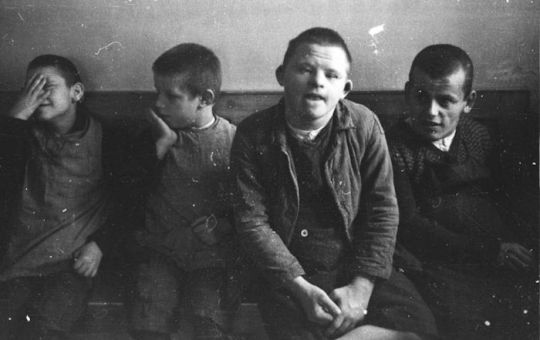
“ Children with Down syndrome sit at Schönbrunn Psychiatric Hospital, 1934. Mentally challenged children were forcibly sterilized to keep them from breeding. They were, initially, taught in separate classrooms, but then considered to be "unteachable." Later, children like these would be killed in order to remove them from the population.”
(image via Wikimedia Commons, caption credit here )
This would be like remembering that the Amazonian Rainforest was being intentionally slashed and burned to clear it for farmland, but to forget that this land includes “protected” tribal lands of those tribes in Brazil. This changes the meaning of the action from; humans need land to provide for a growing population and are willing to sacrifice forest for farm; to, these people are willing to push people from their homes and villages and kill them if they show resistance. To forget that crucial tidbit would be to forget that the people heading these developments value money over human life. To forget this revokes our right to an opinion or voice on the matter.
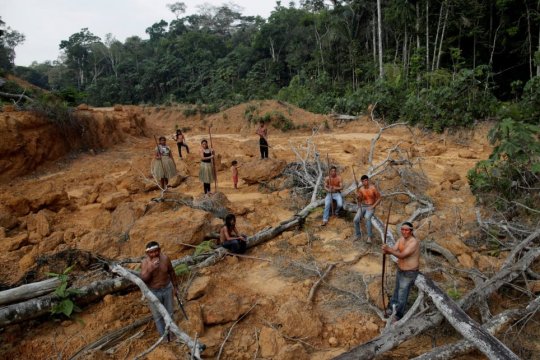
“Amazon tribe looks on helplessly as rainforest is destroyed by man and fire”
(caption and image credit here)
As stated by George Santayana, “Those who cannot remember the past are condemned to repeat it.” And to this I add, to forget the past is to forget what makes us human. Complete knowledge of past events helps to inform us on the moral and consequential implications of our choices.
These meanings can also be applied to another quote I was reminded of when reading Edward Hyams’ statement;
“The nature of our immortal lives is in the consequences of our words and deeds that go on apportioning themselves throughout all time. Our lives are not our own; from womb to tomb, we are bound to others, past and present, and by each crime and every kindness, we birth our future.” - Cloud Atlas (2012) film
It resonates the meaning and reminder that your actions not only have an emotional impact on those around you, but that every action has consequences, whether positive, negative, neutral, or mixed, everything you do will coalesce into a new event, whether directly or indirectly. We live in a universe where our past affects our future constantly; history is now, whether we accept it or not; whether we remember it or not.
7 notes
·
View notes
Photo
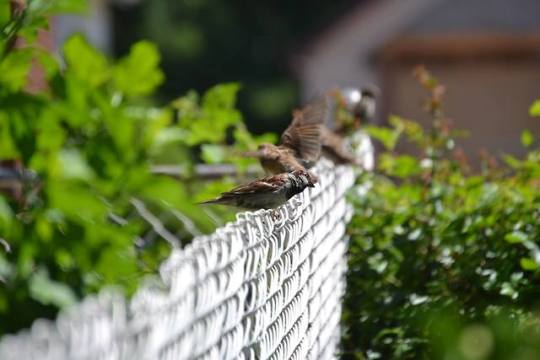
18. There are at least 35 different sparrow species in North America alone.
1 note
·
View note
Photo

17. The amount of yellow on the Yellow-Headed-Amazon parrot’s head increases with age.
1 note
·
View note